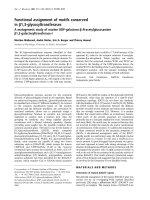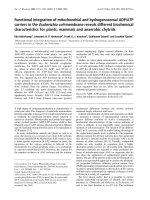Báo cáo y học: "Functional significance of nerve growth factor and its receptor (TrkA) in inflammatory arthritis" pps
Bạn đang xem bản rút gọn của tài liệu. Xem và tải ngay bản đầy đủ của tài liệu tại đây (164.06 KB, 2 trang )
We read the article by Barthel and colleagues [1] in this
is sue of Arthritis Research & erapy with great interest.
ey reported that neurotrophin receptors/ligands and
specifi cally nerve growth factor (NGF) and NGF receptor
(NGF-R) (TrkA and p75) are expressed in synovial fl uid
(SF) cells and synovial tissue (ST) of patients with rheu-
ma toid arthritis (RA) or spondyloarthritis (SpA). e
authors also looked for the cellular source of NGF and
demonstrated that the T cells and monocytes/macro-
phages derived from SF of patients with RA/SpA are
enriched with NGF. Furthermore, they reported that ST-
derived fi broblast-like synoviocytes (FLSs) did not pro-
duce NGF in vitro. In a recent publication, we observed
similarly that NGF levels in SF were signifi cantly higher
in patients with psoriatic arthritis (PsA) (365.5 ± 85.2 pg/
mL) or RA (120 ± 35 pg/mL) than in patients with osteo-
arthritis (OA) (30 ± 6 pg/mL) [2]. However, in regard to
the source of NGF, we observed that FLSs produced a
signifi cant amount of NGF. Here, we would like to share
our observations about the NGF/TrkA system in human
FLSs and its function.
Synovial biopsies from patients with meniscal injury
without any other joint diseases or PsA, OA, or RA were
collected. FLSs were isolated and examined for NGF/
NGF-R expression in accordance with our standardized
protocols [2]. Using a highly sensitive enzyme-linked
immuno sorbent assay (ELISA) for human NGF
(NGFEmax assay; Promega Corporation, Madison, WI,
USA) and Hi-D fl uorescence-activated cell sorting
analyses, we observed that under basal conditions FLSs
from healthy individuals express low levels of NGF/TrkA.
However, there was a marked upregulation of NGF and
TrkA in these FLSs following stimulation with tumor
necrosis factor-alpha and interleukin-1-beta (Table 1). A
critical observation was that FLSs from patients with PsA
or RA produced spontaneously higher levels of NGF and
had increased expression of TrkA compared with FLSs of
patients with OA (Table 1). Furthermore, we observed
that NGF signifi cantly stimulated the proliferation of
FLSs derived from PsA synovial tissue (Figure 1). Barthel
and colleagues [1] cultured FLSs from only one patient
with RA and one patient with SpA and noticed that FLSs
did not produce NGF, but the authors do mention that
they can’t rule out the production of NGF by FLS. We
cultured FLSs from 15 subjects (Table 1), and it is also
possible that the NGF ELISA kit that we used is more
sensitive.
A fully formed pannus is characterized by proliferation
of FLSs, infl ammatory infi ltrates, and a marked angio-
genesis. NGF and its receptor system are known to
© 2010 BioMed Central Ltd
Functional signi cance of nerve growth factor
andits receptor (TrkA) in in ammatory arthritis
Smriti K Raychaudhuri and Siba P Raychaudhuri*
See related research by Barthel et al., />LETTER
*Correspondence:
VA Medical Center Sacramento and University of California-Davis School of
Medicine, Department of Medicine-Division of Rheumatology, Allergy and Clinical
Immunology, 1911 Geneva Place, Davis, CA 95618, USA
Figure 1. Fibroblast-like synoviocyte (FLS) proliferation study
by MTT assay: e ect of nerve growth factor (NGF) on the
proliferation of cultured FLSs derived from patients with
psoriatic arthritis. Third-passage FLSs (5,000 cells per 200 μL of
Dulbecco’s modi ed Eagle’s medium complete medium) in 96-well
plates were cultured for 5 days with NGF-β (100 ng/mL) with or
without anti-NGF neutralizing antibody (neut-ab). The optimal dose
(OD) of NGF was determined by performing a dose response curve.
Data are expressed as the mean ± standard deviation of triplicate
cultures from three independent experiments. NGF demonstrated
a signi cant mitogenic e ect on FLSs. NGF neutralizing antibody-
inhibited NGF-induced proliferation further substantiates that NGF-
induced proliferation of FLSs is a speci c biological action of NGF.
MTT, 3-(4,5-dimethylthiazol-2-yl)-2,5-diphenyltetrazolium bromide.
med
NGF
NGF+neut-ab
0
0.2
0.4
0.6
0.8
1
1.2
med
NGF
NGF+neut-ab
0
0.2
0.4
0.6
0.8
1
1.2
OD
med
NGF
NGF+neut-ab
0
0.2
0.4
0.6
0.8
1
1.2
med
NGF
NGF+neut-ab
0
0.2
0.4
0.6
0.8
1
1.2
OD
Raychaudhuri and Raychaudhuri Arthritis Research & Therapy 2010, 12:404
/>© 2010 BioMed Central Ltd
infl uence angiogenesis and cell traffi cking [3]. In patients
with RA or PsA, pannus tissue adheres to the surface of
articular cartilage; proliferating FLSs produce proteinases
that degrade cartilage and underlying cortical bone [4].
We noticed that proinfl ammatory cytokines upregulate
NGF/TrkA in FLSs, NGF/TrkA is upregulated in FLSs of
infl ammatory arthritis (Table 1), and NGF is mitogenic to
FLSs (Figure 1). ese observations suggest an autocrine
loop of NGF for FLS proliferation and suggest that
dysregulated production of NGF has the potential to
infl uence the infl ammatory and proliferative cascades of
PsA and RA.
Abbreviations
ELISA, enzyme-linked immunosorbent assay; FLS, broblast-like synoviocyte;
NGF, nerve growth factor; NGF-R, nerve growth factor receptor; OA,
osteoarthritis; PsA, psoriatic arthritis; RA, rheumatoid arthritis; SF, synovial uid;
SpA, spondyloarthritis; ST, synovial tissue.
Competing interests
The authors declare that they have no competing interests.
Published: 28 June 2010
References
1. Barthel C, Yeremenko N, Jacobs R, Schmidt RE, Bernateck M, Zeidler H, Tak PP,
Baeten D, Rihl M: Nerve growth factor and receptor expression in
rheumatoid arthritis and spondyloarthritis. Arthritis Res Ther 2009, 11:R82.
2. Raychaudhuri SP, Raychaudhuri SK: The regulatory role of nerve growth
factor and its receptor system in broblast-like synovial cells. Scand J
Rheumatol 2009, 38:207-215.
3. Raychaudhuri SK, Raychaudhuri SP, Weltman H, Farber EM: E ect of nerve
growth factor on endothelial cell biology: proliferation and adherence
molecule expression on human dermal microvascular endothelial cells.
Arch Dermatol Res 2001, 293:291-295.
4. Wernicke D, Schulze-Westho C, Brauer R, Petrow P, Zacher J, Gay S,
Gromnica-Ihle E: Stimulation of collagenase 3 expression in synovial
broblasts of patients with rheumatoid arthritis by contact with a three-
dimensional collagen matrix or with normal cartilage when coimplanted
in NOD/SCID mice. Arthritis Rheum 2002, 46:64-74.
doi:10.1186/ar3030
Cite this article as: Raychaudhuri SK, Raychaudhuri SP: Functional
signi cance of nerve growth factor and its receptor (TrkA) in in ammatory
arthritis. Arthritis Research & Therapy 2010, 12:404.
Table 1. Unstimulated broblast-like synoviocytes of patients with psoriatic arthritis or rheumatoid arthritis express
higher levels of nerve growth factor and TrkA
FACS analyses, percentage of cells
Cells NGF, pg/mL NGF
+
TrkA
+
p75
+
Unstimulated FLSs (meniscal injury n = 4) 30 ± 5 4.5 ± 0.3 1.33 ± 0.4 0.5 ± 0.05
FLSs + IL-1β (meniscal injury) 110 ± 28
a
12.4 ± 2
a
16.5 ± 5
a
0.4 ± 0.2
FLSs + TNF-α (meniscal injury) 129 ± 23
a
6.3 ± 4
a
11.5 ± 5
a
0.71 ± 0.4
FLSs from patients with PsA (n = 3) 105 ± 15
a
17 ± 4
a
10 ± 3
a
1.0 ± 0.4
FLSs from patients with RA (n = 4) 65 ± 4
b
8 ± 0.4
b
5.5 ± 0.4
b
0.5 ± 0.4
FLSs from patients with OA (n = 4) 34 ± 2 3.9 ± 0.2 0.9 ± 0.2 0.7 ± 0.2
Third-passage broblast-like synoviocytes (FLSs) (5,000 cells in 200 μL of Dulbecco’s modi ed Eagle’s medium [DMEM] complete medium) in 96-well plates were
cultured for 6 days. Unstimulated cells were cultured in DMEM only, and stimulated cells were cultured in DMEM with cytokines tumor necrosis factor-alpha (TNF-α)
(1 ng/mL) and interleukin-1-beta (IL-1β) (1 ng/mL). Data are expressed as mean ± standard deviation. Nerve growth factor (NGF), TrkA, and p75 data of unstimulated
FLSs were compared with NGF, TrkA, and p75 data of FLSs of other groups mentioned in the table.
a/b
Signi cantly di erent from unstimulated cells (
a
P <0.001,
b
P <0.05
Student t test). FACS, uorescence-activated cell sorting; OA, osteoarthritis; PsA, psoriatic arthritis; RA, rheumatoid arthritis.
Raychaudhuri and Raychaudhuri Arthritis Research & Therapy 2010, 12:404
/>Page 2 of 2









